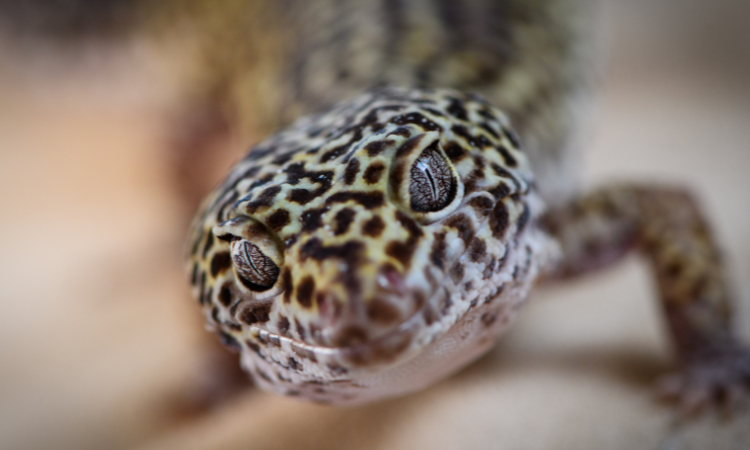If you’re a gecko owner, you know that these lizards like it warm. But just how hot is too hot for a leopard gecko tank? We’ll explore the answer to this question in today’s blog post. So whether you’re new to gecko ownership or have been keeping these reptiles for years, keep reading to find out more about the ideal temperature for your leopard gecko’s home.

Leopard geckos are native to warm climates and need a tank that is at least 80 degrees Fahrenheit.
Leopard geckos are a species of gecko native to warm climates, and they require a proper environment to thrive. In captivity they need a tank that is kept at least 80 degrees Fahrenheit. If the gecko tank is not warm enough, the gecko can be prone to health issues and their immune system won’t develop properly.
Investing in an under-tank heater for your gecko tank is highly recommended if you’re looking to give your gecko the best environment to grow up in. It may seem like an insignificant thing from our perspective, but these small changes can have a big effect on your gecko’s health and overall well-being.
If the temperature in the leopard gecko’s tank gets too hot, it can cause health problems such as dehydration and heat stroke.
Proper heat regulation is paramount for geckos, especially those kept as pets. Keeping a leopard gecko’s tank at a safe temperature keeps these animals healthy and safe from illnesses like dehydration and heat stroke.
It’s important to equip tanks with both a warm side and cool side, so geckos can regulate their temperature by moving between the two spots. If the gecko does overheat, immediately move it to a cooler area or spray its body with cool water to lower its body temperature.
With proper care and monitoring, pet owners can prevent any potential health-related issues that occur from improper temperature levels in gecko tanks.

It is important to have a thermometer in the leopard gecko’s tank so you can monitor the temperature and make sure it stays within a safe range.
A leopard gecko is an interesting, low maintenance pet. They require no walking and need minimal veterinary care. An important part of gecko ownership though is monitoring the temperature of their tank with a thermometer.
It is critical that geckos stay in a suitable temperature range for optimal health and wellbeing; if temperatures become too high or too low it can cause stress, diseases, and other health issues.
Look for a digital thermometer with both Fahrenheit and Celsius readings close to the gecko’s basking spot, as this helps you to understand how comfortable your gecko is feeling.
Replacing the thermometer regularly will ensure that you are receiving accurate readings and can keep your gecko in the best condition possible!
If the temperature in the leopard gecko’s tank gets too high, you can lower it by adding ice cubes or frozen water bottles to the tank.
Keeping the temperature just right in your leopard gecko’s tank is essential for its health and comfort. The ideal temperature range for geckos is between 80-90°F, with a basking spot around 90°F. If the temperatures get too high, you can lower it by adding ice cubes or frozen water bottles to the tank.
It should lower the temperature significantly, but be sure to keep an eye on it in case adjustments need to be made. Keeping the gecko comfortable and safe from sudden shifts in temperature will enable them to thrive in captivity.

You should also provide your leopard gecko with hiding places so it can escape the heat if necessary.
Leopard geckos are unique in their need for special hiding spots. The heat generated from their lights and heating pads can quickly become uncomfortable for geckos, so providing your gecko with appropriate places to hide and escape it can be beneficial.
Hides should be shallow caves or sacks that a gecko can easily find refuge in but also feel secure within, such as a box filled with silk vines or an artificial avocado.
Hiding places do more than just provide geckos with comfortable temperatures; they also allow them to satisfy their natural instinct to hide, making them more content overall.
In conclusion, leopard geckos need tank temperatures to stay around 80 degrees Fahrenheit in order for them to be healthy and happy. It is important to use a thermometer to check the temperature regularly and make sure it does not get too high.
If the temperature does get too high, you can lower it by adding frozen items such as ice cubes or water bottles. Additionally, providing hiding places for the leopard gecko will ensure that it has a spot to go if it needs a break from the heat.
Overall, keeping your pet’s environment comfortable is essential for their health, so always keep an eye on their tank temperature and be aware of how they’re feeling!
Related posts:

Hi – I’m Erika, the lead gecko enthusiast here at Geckopedia! I write articles about pet geckos, including what to feed your leopard gecko and how to help your pet gecko live a long, happy life! I graduated with advanced degrees from UC-Berkeley, the University of Southern California (USC) and Indiana University-Bloomington, where I studied Biology and Animal Science. I use my experience to help others learn about gecko care, and I am an advocate for all topics gecko related!
